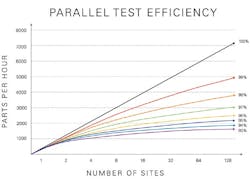The Next Best Thing to a Crystal Ball for Your Test Strategy
You may recall that in January, I discussed three New Year’s resolutions for engineering leaders in 2015. One of those resolutions was adopting a modular hardware platform to help organizations significantly lower their test costs.
I recently read an article completely unrelated to automated test that made me think of the compelling need for those New Year’s resolutions. Patrick James from Fast Company wrote an interesting column titled, “Mapping the Future of Education Technology ,”in which he states “…65% of today’s grade-school children will end up at jobs that haven’t been invented yet.” The assertion struck me, not just because I have kids that will enter the workforce in the next five years, but also because of the rapid technology advances in our industry. It’s safe to say that many of the products and systems your company will create in the near future haven’t been invented yet, or if they have, will possess functionality that’s new and different than what’s in them today.
This file type includes high resolution graphics and schematics when applicable.
Facing the Inevitability of Change
Consider the implication of this scenario on your test systems. While it varies by industry, the average lifespan of a test system is between five and seven years. In other words, a test system deployed today will need to test devices and protocols released seven years from now. These devices will include either newly invented functionality or, at the very least, have different functionality than today’s versions.
Now consider how much is likely to change in the next five to seven years in your industry. The Internet of Things is adding sensors and wireless antennas to everything. By 2020, when we have tens of billions of things connected, 5G should also be in place. The standards are far from set for 5G, but some key technologies will significantly improve bandwidth (Fig. 1). For example, consider ultra-wideband millimeter-wave (mmWave) communication, which will necessitate bandwidth of 1 GHz or more. Currently, the widest-bandwidth, high-performance microwave signal analyzer on the market only has 765 MHz of instantaneous bandwidth.
Furthermore, new test requirements, such as the need to implement digital pre-distortion (DPD) algorithms on the analyzer to test advanced devices, increase bandwidth needs by 2X to 3X that of the wireless signal itself. For design and test engineers across nearly all industries, ensuring that the platform investments made today are prepared to economically accommodate the needs of tomorrow isn’t a hypothetical exercise—it’s a must to stay competitive.
So how do you create test systems that give you the longevity needed to get a good ROI on your test investment, while also giving you the ability to adapt to unforeseen needs that will likely arise during the lifetime of that test system? The answer lies in adopting open, modular test system architectures that make it possible to add or replace measurement functionality at any time.
Enabling Instrumentation Evolution
I witnessed such a need during a visit to Taiwan last year. I was talking to a company about NI’s new Semiconductor Test System (STS). The STS is a production-ready test system based on PXI, the leading modular instrumentation platform in the world. This company was commenting that its semiconductors were incorporating more and higher-performance RF functionality. The company built its traditional testers on proprietary technologies, and it doesn’t have an architecture that can be easily adapted to add RF measurements. Therefore, the solutions for testing RF are bolted on. That is, they’re added as external systems that increase size and complexity, are difficult to integrate, and struggle to meet increasing test throughput needs. The cost of getting the new functionality also runs high—potentially millions of dollars—because the company must depend on the vendor to provide the new capability.
The person we met with asked a very simple and obvious question: With a PXI-based system, when our RF measurement requirements increase or even completely change, can we open up the STS and replace the instrument with a newer model? The answer, of course, is yes. Because the PXI platform is modular, the company can add, for example, an RF signal analyzer with more bandwidth.
Obviously, there’s more to it than simply putting the new instrument in the PXI chassis. There will be some cost for integrating the new instrument into existing test plans, which could also be mitigated with the right software architecture (the subject of another New Year’s resolution). Nonetheless, the cost will be small compared to completely replacing the test system.
Increasing Parallel Test Efficiency
The benefits of a modular test platform extend beyond the instrumentation. I’ll continue with another example from the semiconductor industry. In semiconductor assembly and test, production parts per hour (PPH) is king. Managers or directors of the facilities know that getting to the ideal PPH number requires balancing the right number of test systems that have the right parallel test efficiency (PTE) for the right price.
In particular, PTE is useful when looking at the critical point in the relationship between the PPH and number of sites in a multi-site test system. A perfect scenario would be a 100% PTE for a system (Fig. 2). The reality is that every system has overhead, so 95% is a typical value for a good test system. This graph reveals other implications, too. For example, increasing the number of test sites on a multisite test system typically increases the capital expense of a test system. And for a given system configuration and test sequence, the PTE is fixed (assuming the system is fully optimized), unless the system is overhauled.
In the same way that engineers who use PXI are able to easily upgrade or modify their wireless test systems by incorporating newly available instrumentation, semiconductor engineers can enhance their test systems by upgrading the CPU. The number of cores and parallel threads that are executable with a CPU is a big driver of PTE. So when we released an eight-core PXI controller based on Intel Xeon technology, semiconductor engineers could increase the PTE of their test systems by up to two percentage points with minimal incremental investment. Since a typical system PTE can only improve five percentage points, this represents a significant improvement and can mean hundreds or thousands more PPH in throughput. It’s important to note that having the right software platform and architecture is critical to gaining such a benefit in processing performance.
This file type includes high resolution graphics and schematics when applicable.
I’ll conclude by restating the obvious: The test-platform decisions you make today will impact your competitiveness tomorrow. Sorry to say, I can’t offer you a crystal ball that provides a view of exactly what’s ahead. I can, however, recommend the next best thing: Plan for change. Resolve this year to assess the adoption of a modular test strategy and platform. Your traditional test-system vendors won’t like it and it may be a change for some of your engineers. However, taking a lesson from Patrick James’ column, there’s a lot about the future we don’t know yet, and it’d be a real mistake to not prepare today for what is surely coming tomorrow.
About the Author
Mike Santori
Vice President of Product Marketing
Mike Santori, vice president of product marketing at National Instruments, leads the organizations that are responsible for planning and marketing core measurements, test systems, embedded systems, and key application segments. He focuses on optimizing the NI product portfolio, leading the definition and management of new products, and ensuring high-quality technical marketing. Since joining NI in 1986, he has worked closely with R&D and marketing to define new products and capabilities for NI software, including NI LabVIEW, NI LabWindows/CVI, NI TestStand, and NI VeriStand, as well as develop marketing strategies for NI’s graphical system design approach. He holds a bachelor’s degree in electrical engineering from Texas A&M University.




